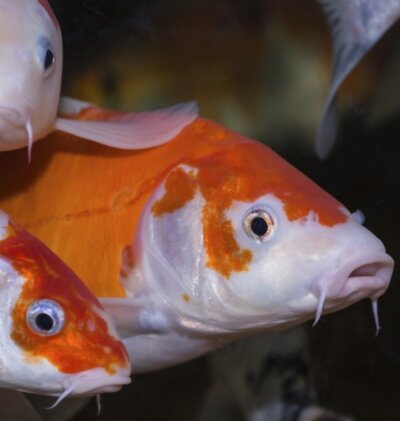
Koi selectively bred for colours, pattern and body shape
Amazing! “Would you believe that Koi carp can sell for up to £10,000 and the oldest Koi on record lived for 200 years! Typically growing up to three feet long…that’s big business!”
Over the years Koi have been selectively bred for colours, pattern and body shape and not necessarily for resistance to bacteria, parasites and viruses.
Koi are more fragile than you think
Many people think that koi are the same as carp and therefore extremely hardy. And while it is true that koi are technically carp, they are distant cousins to the wild fish you see in lakes. Because of the selective breeding process used, Koi have lost much of that wild hardiness and they are more fragile than you might think.
One of the most common diseases in koi is called Cyprinid herpesvirus 3, also known as Koi herpesvirus (KHV) belonging to the family of Alloherpesviridae. It is spread world-wide, mainly by intensive international fish trading, and strains from different countries were shown to have high similarities. The virus causes a highly contagious and acute viraemia in common carp (Cyprinus carpio) and its variant, the Koi carp (C. c. koi). This devastating virus disease may result in mortality rates between 70 and 100 %. Interestingly, the disease is temperature dependent, mostly occurring between 16 and 25 °C. All age groups of carp appear to be susceptible to KHV, although, generally, younger fish up to one year are more susceptible to clinical disease.
High levels of virus DNA have been shown to be present
The mode of transmission of KHV is horizontal, but vertical transmission cannot be ruled out. Horizontal transmission may be direct or vectorial, water being the major abiotic vector. KHV remains active in water for at least 4 hours at water temperatures of 23–25 °C. The virulent virus is shed via faeces, urine, gills and skin mucus. Infection mainly occurs via the skin. After entry, the virus spreads systemically from the portal of entry to superficial and internal organs. High levels of virus DNA have been shown to be present in skin, gills, spleen, liver and gut tissues.
Clinical signs of KHV can be difficult to distinguish from other fish diseases and generally include an evident hyper-secretion of mucus in the early stage of infection. Additional typical clinical signs are loss of appetite, discolouration of skin and gills as well as skin lesions. Sunken eyes (enophthalmia) and necrotic gills are frequently seen. Due to its potential to cause considerable economic damage, the disease is listed as a notifiable disease by the world animal health organization OIE (www.oie.int).
To limit disease spread, a rapid identification of KHV in diseased or dead fish is crucial
The use of FASTest KOI HV as a fast “pond-side” test enables veterinarians, Koi owners, breeders, importers and/or pet shops a fast aetiological diagnosis of a fresh and acute KHV infection.
For further information about our new FASTest KOI HV test kit follow this link
To find out more about our large range of veterinary diagnostic test kits visit our website: www.vetlabsupplies.co.uk or Telephone: 01798 874567

